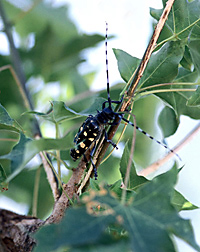This page has been archived and is being provided for reference purposes only. The page is no longer being updated, and therefore, links on the page may be invalid.
Read the magazine story to find out more. |
|
To Bag a Bad Beetle, Researchers Tap Forensic Science
By Erin PeabodyMay 4, 2006
Tracking the elusive Asian longhorned beetle (ALB) could soon get a whole lot easier—and weirder. Agricultural Research Service (ARS) scientists have developed a novel "fingerprinting" tool that relies on analyzing, of all things, the invasive beetle's droppings to help give it away.
According to ARS insect geneticist Wayne Hunter, what's so telling about the insect's "frass," is that it has a genetic signature that's totally unique to the beetle. Hunter works in the agency's Subtropical Insects Research Unit at Fort Pierce, Fla.
So Hunter, with help from ARS insect behaviorist Michael T. Smith, developed genetic markers that can be used to screen frass found on trees known to attract ALB. If a sample matches the insect's established genetic profile, beetle hunters will know they've got a potential infestation on their hands. Frass is only one sign of an ALB infestation. Beetle hunters also look for the dime-sized, perfectly round holes left by emerging adult beetles, as well as pits that mark locations where eggs have been laid.
Two things make the ALB one of the country's most "wanted" invasives. First, its ravenous appetite for hardwoods—like maple, elm and birch—threatens forests and tree-lined neighborhoods across the East. Second, a quiet killer, the beetle inflicts its greatest damage while hidden deep inside trees. Immature ALBs create elaborate tunnels while feeding there, weakening trees until they finally snap in half or must be cut down.
Adding to the ALB toolbox, Smith has also developed a method for detecting the alien insect. Smith, who works in the ARS Beneficial Insects Introduction Research Unit at Newark, Del., has shown that a chemcial—a pyrethroid called Demand—can knock down adult, free-flying beetles in just minutes.
Using the insecticide as a fast-acting detector, beetle-hunting crews could simply spray trees suspected of harboring the insects and wait for the bugs to fall. Now, crews climb trees one by one and scrutinize bark for the faintest signs of ALB activity.
Officials with the ALB Cooperative Eradication Program--administered by the Animal and Plant Health Inspection Service--believe the new technique could have a limited application in certain circumstances in the detection component of the program and are evaluating its potential impact on the human and natural environment.
Read more about the research in the current issue of Agricultural Research magazine.
ARS is the U.S. Department of Agriculture's chief scientific research agency.

